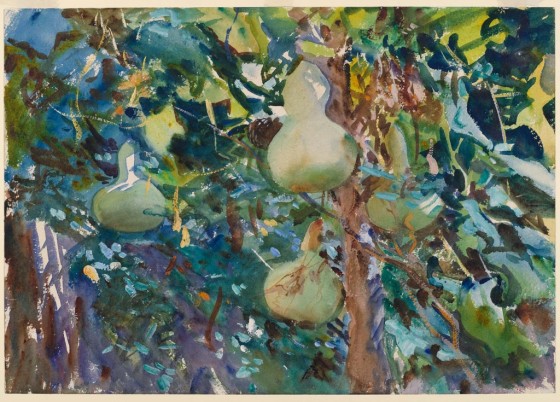John Singer Sargent’s Watercolors, MFA
Through January 20, 2014, in the Gund Gallery at the Museum of Fine Arts in Boston, you can see an outstanding exhibition of watercolor paintings by John Singer Sargent (1856 – 1925), who is best known for his portraits. Rosemary and I spent the morning at the museum yesterday, and the place was packed with people. Every time I go I am more impressed by what the museum trustees and staff have done to make the MFA a world-class museum. The museum feels fresh inside. The presentation of artworks is more bold now, even down to the choice of wall color in some smaller spaces. The galleries, corridors, cafes, and gift shop were full of people. A long line of folks waited for the start of a film, “The Art of Proust.” A two-part narrative bronze sculpture of a Native American hunting an elk has been added to the entrance plaza that faces the Fenway, lined with swaths of tall reeds.
The Sargent exhibition is a partnership with the Brooklyn Museum. Some of the more remarkable paintings are from the artist’s travels to the Mediterranean and Middle East in 1905-06: marble quarries in Italy, Bedouin camps in North Africa, village wine-makers, boats in Corfu. The art critics praise Sargent’s rendering of light in our immediate world—the highlights and shadows and glow—and the way he makes us see the color white all around us, often in non-white hues. Rosemary quoted someone saying that Sargent applied watercolor with a hand that moved like he was playing a piano, light and quick and sure. You can see that in the brushstrokes. I studied watercolor painting for one semester with Carlton Plummer at UMass Lowell in the mid-1970s. Carlton, who is a master of the medium, always said “Think like a turtle, and paint like a rabbit” when handling watercolor paint. Sargent’s images are more than 100 years old, yet retain the freshness of their original moments. According to the show catalog, he made more than 2,000 watercolor paintings in his lifetime—about 100 are on display, taken from two large collections of these works, those owned by the MFA and another large set from the Brooklyn Museum.
